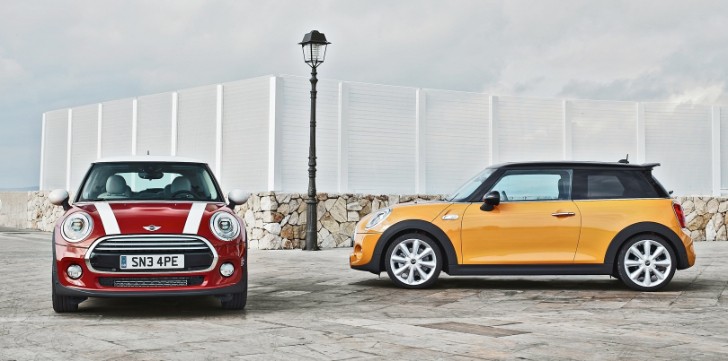Now, that the 2014 MINI Cooper has been properly introduced to the world, we can take a closer look at how it’s different from its predecessor, in both specs and looks.
As far as the specs go, the new models will be using a completely different range of engines, all of them new, aimed at reducing fuel consumption and CO2 emissions.
The base model, the 2014 MINI Cooper will be using a 1.5-liter 3-cylinder turbocharged petrol unit that allows the 1,160 kg (2,557 lbs) car to reach the benchmark 100 km/h (62 mph) speed in 7.9 seconds for the manual, 7.8 seconds for the new automatic 6-speed transmission.
Compared to its predecessor, that’s a 1.2 second improvement whilst the fuel consumption figures were also drastically changed. If the old MINI averaged around 43 mpg (5.4 l/100 km), this one goes even further, averaging around 51 mpg (4.6 /100 km).
Going over the diesel alternative, the MINI Cooper D will be leaving the 1.6-liter unit behind and go for a similar 1.5-liter 3-cylinder one, as found in the petrol Cooper. The numbers haven’t drastically changed here, though.
The new engine will have 116 HP and 270 Nm (200 lb-ft) of torque, compared to the 112 HP of its predecessor. The sprint is now done in 9.2 seconds, half a second faster than before, no matter if it’s an automatic or manual.
As for the fuel consumption, at the moment, the official press release claims the Cooper D will return an average 65 mpg (3.6 l/100 km), slightly better than its predecessor than claimed 61 mpg (3.8 l/100 km).
Going over the S model, the new car will be using a 2-liter 192 HP and 280 Nm (300 Nm with overboost) engine and, depending on your needs, a 6-speed gearbox that can be either automatic or manual.
The 0-100 km/h (0-62 mph) sprint is done in 6.8 seconds for the manual and 0.1 seconds faster with the automatic, 0.2 respectively 0.3 faster than the model it replaces.
As for the fuel consumption, when fitted with the automatic 6-speed, the claimed average mpg should be around 44 (5.3 l/100 km), whilst the manual is a bit more thirsty, returning 41 mpg (5.7 l/100 km).
The base model, the 2014 MINI Cooper will be using a 1.5-liter 3-cylinder turbocharged petrol unit that allows the 1,160 kg (2,557 lbs) car to reach the benchmark 100 km/h (62 mph) speed in 7.9 seconds for the manual, 7.8 seconds for the new automatic 6-speed transmission.
Compared to its predecessor, that’s a 1.2 second improvement whilst the fuel consumption figures were also drastically changed. If the old MINI averaged around 43 mpg (5.4 l/100 km), this one goes even further, averaging around 51 mpg (4.6 /100 km).
Going over the diesel alternative, the MINI Cooper D will be leaving the 1.6-liter unit behind and go for a similar 1.5-liter 3-cylinder one, as found in the petrol Cooper. The numbers haven’t drastically changed here, though.
The new engine will have 116 HP and 270 Nm (200 lb-ft) of torque, compared to the 112 HP of its predecessor. The sprint is now done in 9.2 seconds, half a second faster than before, no matter if it’s an automatic or manual.
As for the fuel consumption, at the moment, the official press release claims the Cooper D will return an average 65 mpg (3.6 l/100 km), slightly better than its predecessor than claimed 61 mpg (3.8 l/100 km).
Going over the S model, the new car will be using a 2-liter 192 HP and 280 Nm (300 Nm with overboost) engine and, depending on your needs, a 6-speed gearbox that can be either automatic or manual.
The 0-100 km/h (0-62 mph) sprint is done in 6.8 seconds for the manual and 0.1 seconds faster with the automatic, 0.2 respectively 0.3 faster than the model it replaces.
As for the fuel consumption, when fitted with the automatic 6-speed, the claimed average mpg should be around 44 (5.3 l/100 km), whilst the manual is a bit more thirsty, returning 41 mpg (5.7 l/100 km).
